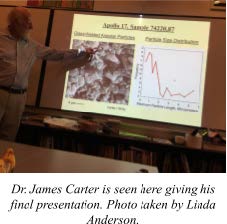Dr. James Carter, Pioneering Lunar Geologist, Passes Away
Dr. James L. Carter, geoscientist, and associate professor emeritus at the University of Texas at Dallas, passed away on September 21, 2019, in his home at the age of 82. Dr. Carter was one of the leading geologists on the Apollo mission to the Moon, and played a role in training the Apollo crews in the field of geology. His work led to numerous achievements, including the collection of Genesis Rock, the largest lunar sample at the time. He was later recruited by NASA Johnson Space Center in Houston, Texas, to pioneer the creation of a simulated prototype for a lunar sample known as JSC-1. He developed novel methods and machinery that pushed the limits of his field, and in 2003, founded ETstimulants, to manufacture and supply over 50 tons of simulated moon dust. While working at NASA, he was also one of the leading geologists who discovered the neck of an Alamosaurus, one of the biggest dinosaur fossils excavated in Texas. In 1964, Carter was recruited from Rice University, where he received his Ph.D., to enter the Graduate Research Center of the Southwest and the Southwest Center for Advanced Studies as one of the first researchers. He remained with the center when it became the University of Texas at Dallas in 1969.

The Leonardo journal would like to give its condolences to the family of Dr. James Carter.
Written by Arya Agrawal ( 0000-0003-0964-5254)
Leonardo as an artist and scientist utilized both art and science simultaneously. Our tendencies today are to separate these two methodologies. Dr. James Carter tagged as a scientist, explored science using artistic methods and creating machinery to achieve his goals. As a geoscientist and associate professor emeritus, Carter demonstrated his ease of moving from one form to another when asked to recreate lunar dust for scientific investigations in space research. Moon dust from NASA was in limited supply.
As a geologist, Carter analyzed the moon dust components to its specific elements and then created a method to grind and homogenize the elements to create literally tons of moon dust. Carter used artistic methods carefully grinding, measuring and created his own grinding machine. As an artist he knew when the perfect consistency for dust had been reached. NASA tested batch after batch for consistency and accuracy, only to conclude that Carter had perfected his method using his own invented machinery.
Who was Professor James Carter? Here in Dallas, we were late to discover his dual talents. Dr. James Carter, as a leading geologist on the Apollo mission to the moon, trained the Apollo crews in geology. What would the astronauts discover and find different on the moon? With no gravity, Carter moved into a new area of exploration that he continued into 2019. Carter received his PhD at Rice University in 1964 and was recruited by the newly created Graduate Research Center of the Southwest and the Southwest Center for Advanced Studies, offshoots of Texas Instruments centers for their graduate school scientists. In 1969, the center became the University of Texas at Dallas. Carter’s work on the lunar space sample, JSC-1 was developed in coordination with NASA’s Johnson Space Center in Houston. In 2003 Dr. Carter founded ETStimulants to manufacture and supply over 50 tons of simulated moon dust.
On September 20, 2019, Dr. Carter presented some of his findings, how moon samples did not follow normal formations on Earth, how he had created the methods he used in his science, and his teachings to encourage his students to use scientific and non-scientific methods to explore their ideas. Carter presented these ideas at a new group at UTD designed to combine art and science, The ArtSci-Lab Watering Hole, where artists and scientists present new work, and problems they are working on to solve.
Dr. Carter was much loved by his students. He expired on September 21, 2019 doing what he enjoyed best, working in his laboratory. Dr. Carter is remembered by both UTD and his family. His last lecture can be accessed and a poem dedicated to his spirit of life is appended.
— Linda Anderson
